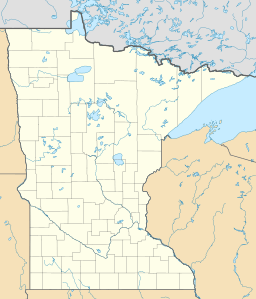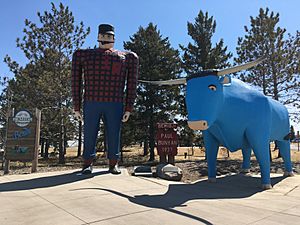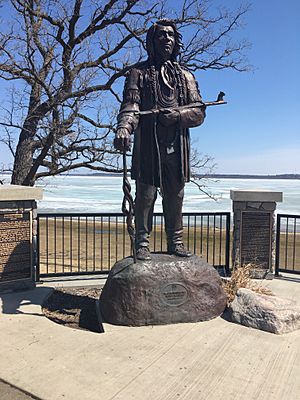Lake Bemidji facts for kids
Quick facts for kids Lake Bemidji |
|
|---|---|
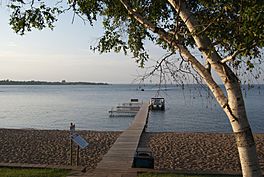 |
|
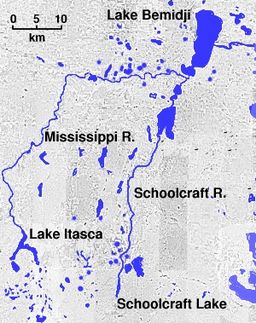
Lake Bemidji, near the headwaters of the Mississippi River
|
|
| Location | Beltrami County, Minnesota, U.S. |
| Coordinates | 47°28′19″N 094°52′35″W / 47.47194°N 94.87639°W |
| Primary inflows | Mississippi River |
| Primary outflows | Mississippi River |
| Basin countries | United States |
| Surface area | 28 km2 (11 sq mi) |
Lake Bemidji is a beautiful lake in northern Minnesota, United States. It was formed by glaciers long ago. The lake is about 11 square miles (28,000,000 m2; 7,000 acres; 2,800 ha) big. The famous Mississippi River flows into and out of Lake Bemidji. It's less than 50 miles (80 km) from where the Mississippi River begins!
Contents
What's in a Name? Lake Bemidji's Meaning
The name 'Bemidji' has a special meaning. It comes from the Ojibwe language. In Ojibwe, the lake is called Bemidjigamaag. This means 'Lake with crossing waters'. It describes how the Mississippi River flows right through the lake from west to east.
Where is Lake Bemidji Located?
The lake is in southern Beltrami County. The city of Bemidji sits on its southwestern shore.
Paul Bunyan's Footprints?
Local folk legends say that Lake Bemidji and nearby Lake Irving were formed by Paul Bunyan's giant footprints! The Ojibwe people saw these lakes as one big lake. They called it a bimijigamaa, meaning a lake that crosses another body of water. This is because the lake crosses the Mississippi River.
The City of Bemidji's Name
Sometimes, the city of Bemidji is called Wabigamaang in Ojibwe. This means 'at the lake channel or narrows'. Part of the city is located on the narrow area between Lake Bemidji and Lake Irving.
Lake Bemidji's Water Source
Lake Bemidji is part of the upper Mississippi River drainage basin. A huge area of over 396,000 acres (160,000 ha) drains water into Lake Bemidji. The lake has about 15 miles of shoreline.
What Lives in Lake Bemidji?
The shallow areas near the shore are called the littoral zone. This zone covers about 28% of Lake Bemidji. As of 2017, there were no known harmful invasive species in the lake.
How Clear is the Water?
You can check how clear the water is using a special tool called a Secchi disk. The water clarity in Lake Bemidji changes throughout the year. It's usually clearest in May and June. Then it gets less clear through August. The water becomes clear again in October. This is normal for lakes in northern Minnesota.
Fish Species in Lake Bemidji
Lake Bemidji is home to many different kinds of fish! Some of the fish you might find include:
- black bullhead
- black crappie
- bluegill
- brown bullhead
- burbot
- green sunfish
- hybrid sunfish
- lake whitefish
- largemouth bass
- muskellunge
- northern pike
- pumpkinseed
- rock bass
- tullibee (cisco)
- walleye
- yellow bullhead
- yellow perch
- bowfin (dogfish)
- greater redhorse
- redhorse
- shorthead redhorse
- white sucker
- banded killifish
- blackchin shiner
- blacknose shiner
- bluntnose minnow
- brassy minnow
- brook stickleback
- central mudminnow
- common shiner
- fathead minnow
- finescale dace
- golden shiner
- Iowa darter
- Johnny darter
- logperch
- longnose dace
- mimic shiner
- spottail shiner
- tadpole madtom
Lake Bemidji's Past
The first people to live in the Bemidji area were Native Americans. They settled here about 10,000 years ago, after the glaciers melted. You can still see signs of these glaciers today in the beautiful nature around Bemidji.
Early Native American Tribes
Over time, different Native American tribes lived around Lake Bemidji. The Dakota arrived in the 1600s. Then the Ojibwe arrived in the 1700s. The Ojibwe became the main tribe in the area through the 1700s and 1800s.
Chief Shaynowishkung: A Local Leader
Chief Shaynowishkung, also known as Chief Bemidji, was an important Ojibwe leader. He was born in 1834 and passed away in 1904. His people originally came from Madeline Island. They moved to Sandy Lake, then Winnibigoshish, and finally settled by Lake Bemidji.
How Chief Shaynowishkung Got His Name
Chief Shaynowishkung moved to Lake Bemidji in 1882. In 1888, he met white settlers for the first time. During this meeting, there was a misunderstanding. Shaynowishkung told them the name of the lake, Bemijigamaag. The settlers thought that was his name! So, he became known as "Chief Bemidji" for the rest of his life.
Logging Mills and Lake Bemidji
Logging became a very important business in the Bemidji area. The Crookston Sawmill opened in 1903. It was located along the south shore of Lake Bemidji. This sawmill grew very quickly. By 1910, it was the second largest sawmill in the country!
Fires at the Sawmill
Sawmills that processed timber were at high risk of fire. The Crookston Sawmill burned down twice in the 1910s and early 1920s. On November 8, 1924, a huge fire destroyed a lot of valuable wood. The heat from this fire was so strong that it created whirlwinds. These whirlwinds tossed burning wood across the lake!
Drought and the Lake
Between 1907 and 1910, northern Minnesota experienced many years of dry weather and forest fires. Because of this dryness, the north and south parts of Lake Bemidji were sometimes separated. A sandbar would appear, making it hard to move logs across the lake to the sawmill.
Paul Bunyan and Babe the Blue Ox Statues
The famous statues of Paul Bunyan and Babe the Blue Ox were built in 1936. They were first shown to the public on January 15, 1937. Since then, the 18-foot tall lumberjack and his blue ox have been a landmark on the south shore of Lake Bemidji.
A National Attraction
It took 737 hours to build the statues, and they weigh 2.5 tons! They quickly became a national tourism legend. After more than 50 years, the statues were added to the National Register of Historic Places. This means they are an important cultural site that should be protected. Today, they are one of the most photographed roadside attractions in the United States.
Fun Things to Do at Lake Bemidji
Lake Bemidji is a popular place for fun activities and vacations. You can enjoy many things on and around the lake.
Activities on the Lake
- fishing
- boating
- swimming
- water-skiing
- tubing
Activities Around the Lake
- hiking
- visiting Lake Bemidji State Park on the northern shore
- biking on the Paul Bunyan State Trail, which starts at the state park and runs along the lake
Parks and Places to Stay
Lake Bemidji is home to several large parks, including Diamond Point Park, Cameron Park, Library Park, and South Shore Park. You can also find resorts, a bed and breakfast, a campground at Lake Bemidji State Park, and many hotels. The south shore area is growing with new businesses, homes, and the Sanford Center.
Images for kids


